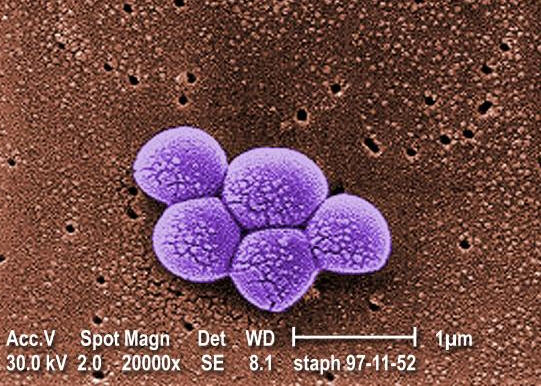代替抗生素來殺菌 研究:超短脈衝光殺死99.9%以上超級細菌MRSA
環境資訊中心外電;姜唯 翻譯;陳範恩 審校;稿源:ENS
聖路易華盛頓大學醫學院的研究人員發現,超短脈衝光可以殺死多重耐藥細菌,例如多重抗藥性金黃色葡萄球菌(Methicillin-resistant Staphylococcus aureus,MRSA)和大腸桿菌。

放大2萬倍後的多重抗藥性金黃色葡萄球菌(MRSA)。圖片來源:Public Health Image Library(PHIL)
超短脈衝雷射光 代替抗生素來殺菌
致命細菌對抗生素的抵抗力越來越強,使得尋找能夠替代抗生素來殺菌的方法愈來愈急迫。發表於《生物光子學》(Journal of Biophotonics)期刊上的研究指出,超短脈衝雷射光是個有潛力的方法,它雖然不會殺死所有細菌,但在某些應用情境下恰好適用。該研究表明,超短脈衝雷射光可以有效殺死其他方法難以摧毀的細菌。
同一個研究團隊先前已經證實,此類雷射光不會損害人體細胞,並且可以消毒傷口或血液製品。
「超短脈衝光技術特殊之處在於可以讓病原體失去活性,但不會傷害人類蛋白質和細胞。」第一作者、華盛頓大學馬林克羅特放射學研究所(Mallinckrodt Institute of Radiology, MIR)放射學講師岑孝偉(Shaw-Wei 「David」 Tsen,暫譯) 醫學博士說,「舉例來說,在縫合前若用脈衝光照射整個手術傷口,就可以降低細菌感染的風險。我認為這項技術很快就能用於消毒體外的生物製品,未來甚至可以搭配血液透析的方式,利用雷射光消毒血液。」
殺死99.9%以上 超短脈衝光對多重耐藥細菌有效
在這份新研究中,研究人員致力於使他們的雷射光殺菌方法能夠對多重耐藥性金黃色葡萄球菌MRSA有效。MRSA會嚴重感染皮膚、肺部和其他器官,甚至帶來致命的後果。
根據美國疾病控制與預防中心(Centers for Disease Control and Prevention, CDC)的資料,在醫院和療養院等醫療機構中,最有可能感染MRSA的患者或居民是已有其他健康問題的人。此外,接受過抗生素治療、有傷口或裝有侵入性醫療器械(如導管)或接受過某些手術(如手術或透析)的患者更可能受到感染。
研究人員也研究雷射光對廣效性乙內醯胺酶大腸桿菌(extended spectrum beta-lactamase-producing Escherichia coli)的殺菌效果,這類細菌可以在環境、食物、人和動物的腸道中被發現,數量龐大且種類繁多。
大多數大腸桿菌菌株是無害的,但有些菌株會導致泌尿道發炎、腹瀉、呼吸道疾病和肺炎以及其他疾病。
MRSA和大腸桿菌是完全不同類型的細菌,來自細菌界的兩個遙遠分支。
研究人員還研究讓雷射光破壞蠟樣芽孢桿菌的孢子,這種無法透過煮沸以及烹調來去除的細菌會導致食物中毒和食物變質。
在上述所有的案例中,超短脈衝光殺死了99.9%以上的目標生物,將它們的數量減少至千分之一以下。
超短脈衝光運作原理
超短脈衝光活化可以活化病毒和細菌排列密集的蛋白質結構。華盛頓大學醫學院研究團隊解釋說,雷射光會使這些蛋白質結構振動直到分子鍵開始斷裂。
斷掉的分子鍵即使快速重組,但大部分情況下也回不去過去的結構,這導致微生物中的蛋白質內部和彼此鍵結混亂錯誤,進而喪失原先功能。
另一方面,研究人員也已經證實,超短脈衝光穿過人體組織並不會造成蛋白質的破壞,也不會殺死任何人體細胞。
「我們之前發表的一篇論文中證明雷射光的功率是關鍵因素,」岑孝偉說,「一定的功率以下可以讓病毒失去活性,功率增加後能開始消滅活細菌。但要使用高上好幾個數量級的功率,才會開始殺死人體細胞。所以只要調整好雷射光參數,就可以在不影響人體細胞的情況下殺死病原體。」
熱、輻射和漂白劑等化學物質雖然可以有效消毒物品,但這些方法對人類組織或生物製品的破壞性太大。超短脈衝光能在不損害人體細胞的情況下滅活各種細菌和病毒,是消毒血液製品和其他生物製品的新方法。
「任何來自人類或動物的東西都可能被病原體污染,」岑孝偉說,「我們在將血液製品輸送給患者之前會對其進行篩驗。問題是我們必須先知道要篩檢什麼。如果一種未知的血源性病毒出現,便會像70年代和80年代的HIV一樣,在我們知道要去篩檢它之前就潛入到血庫中。」
「超短脈衝光可能是一種有效確保要輸入到人體的血液中不存在任何已知或尚未被發現的病原體的方法。」
Lasers that emit ultrashort pulses of light can kill multidrug-resistant bacteria such as MRSA and E. coli, researchers at Washington University School of Medicine in St. Louis have discovered.
Life-threatening bacteria are becoming ever more resistant to antibiotics, making the search for alternatives to antibiotics an urgent challenge. One possibility appears to be this unique type of laser. It does not destroy all such bacteria, but for some applications, ultrashort-pulse lasers are just what’s needed.
The study, online in the “Journal of Biophotonics,” opens the possibility of using ultrashort-pulse lasers to destroy bacteria that are hard to kill by other methods.
The same group of researchers previously had shown that such lasers don’t damage human cells, making it possible to use the lasers to sterilize wounds or disinfect blood products.
“The ultrashort-pulse laser technology uniquely inactivates pathogens while preserving human proteins and cells,” said first author Shaw-Wei “David” Tsen, MD, PhD, an instructor of radiology at Washington University’s Mallinckrodt Institute of Radiology (MIR).
“Imagine if, prior to closing a surgical wound, we could scan a laser beam across the site and further reduce the chances of infection. I can see this technology being used soon to disinfect biological products in vitro, and even to treat bloodstream infections in the future by putting patients on dialysis and passing the blood through a laser treatment device.”
The researchers trained their lasers on multidrug-resistant Staphylococcus aureus, MRSA, which can cause dangerous or even deadly infections of the skin, lungs and other organs.
In healthcare facilities such as hospitals and nursing homes, the patients or residents most likely to get an MRSA infection are those with other health conditions making them sick, according to the Centers for Disease Control and Prevention, CDC. Also, hospital or nursing home patients who have been treated with antibiotics, have wounds or invasive medical devices such as catheters, or have certain procedures like surgery or dialysis are more likely to get an infection.
The researchers also worked with extended spectrum beta-lactamase-producing Escherichia coli, E. coli, a large and diverse group of bacteria found in the environment, foods, and intestines of people and animals.
Most strains of E. coli are harmless, but others can cause urinary tract infections, diarrhea, respiratory illness and pneumonia, and other illnesses.
MRSA and E. coli are entirely different types of bacteria, from two distant branches of the bacterial kingdom.
The researchers also investigated spores of the bacterium Bacillus cereus, which causes food poisoning and food spoilage. Bacillus spores can withstand boiling and cooking.
In all these cases, the ultrashort-pulse lasers killed more than 99.9 percent of the target organisms, reducing their numbers by more than 1,000 times.
How It Works
Viruses and bacteria contain densely packed protein structures that can be excited by an ultrashort-pulse laser. The Washington University School of Medicine research team explains that the laser kills by causing these protein structures to vibrate until some of their molecular bonds break.
The broken ends quickly reattach to whatever they can find, which in many cases is not what they had been attached to before. The result is a mess of incorrect linkages inside and between proteins, and that mess causes normal protein function in microorganisms to grind to a halt.
But passing the ultrashort-pulse laser through human tissue does not create a mess, it kills no human cells, the researchers have shown.
“We previously published a paper in which we showed that the laser power matters,” Tsen said. “At a certain laser power, we’re inactivating viruses. As you increase the power, you start inactivating bacteria. But it takes even higher power than that, and we’re talking orders of magnitude, to start killing human cells. So there is a therapeutic window where we can tune the laser parameters such that we can kill pathogens without affecting the human cells.”
Heat, radiation and chemicals such as bleach are effective at sterilizing objects, but most of these methods are too damaging to be used on people or biological products. By inactivating all kinds of bacteria and viruses without damaging cells, ultrashort-pulse lasers could provide a new approach to making blood products and other biological products safer.
“Anything derived from human or animal sources could be contaminated with pathogens,” Tsen said. “We screen all blood products before transfusing them to patients. The problem is that we have to know what we’re screening for. If a new blood-borne virus emerges, like HIV did in the ’70s and ’80s, it could get into the blood supply before we know it.”
Tsen said, “Ultrashort-pulse lasers could be a way to make sure that our blood supply is clear of pathogens both known and unknown.”
※ 全文及圖片詳見:ENS
查看原始文章>
【全文轉載自環境資訊中心】
(CC BY-NC-ND 4.0)
❤️~ 讓愛遠播 點亮他人 ~❤️
【惜食自介懶人包:惜食行善網是什麼? 可以做什麼?】
''你今天做善事了嗎?''
行善讓您改變一個弱勢者的人生,
也讓您能得到心中的富足與圓滿。
【惜食行善網】讓您可以隨時隨地的做善事
